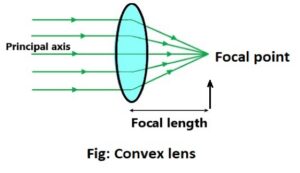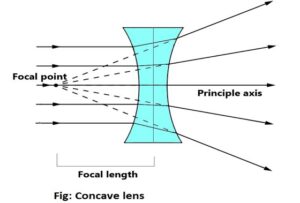
Introduction
A lens is a homogeneous optical device having a transparent medium through which light is refracted they are used to converge and divert light. One or both covers collect light from one side and change its convergence to reflect the other. The word lens comes from the Latin word lentil because the shape of a bi-convex lens is like a pulse. The oldest lens is the Nimrud lens, which was made about 2700 years ago in ancient Assyria. Most lenses have a round cover with two axes. The first axis is the horizontal axis and the second axis is the vertical axis. Most lenses are made of glass, quartz, and plastic and their use is increasing day by day. There are usually two types of lenses convex and concave lens. Concave vs convex lens and their details are described below (2) & (3).
Convex lens

A lens that is thicker in the middle and narrower at the edges is called a convex lens. The incidental parallel rays on the convex lens emit convergence from the lens after refraction. That is why a convex lens is called a converging lens. The rays are incident on the convex surface of the convex lens. This lens converges a bunch of parallel rays at a point. This point is called the focal point of the lens and the distance of this point from the center of the lens is the focal length. The focal length of a convex lens is positive. The light converges at one point on the convex lens and then it spreads again (1) & (4).
Example
The lens used in the camera is a convex lens.
Types of convex lens
There are three types of convex lenses depending on the shape of the surface (1).
1. Double convex lens
A lens that is convex on both sides is called a double convex lens. If the curvature radius of the two surfaces of this lens is equal, then it is called an equiconvex lens.
2. Plano-convex lens
A lens that has one side is flat and the other side is convex.
3. Concave-convex lens
A lens that has one surface concave and the other surface convex is called a concave-convex lens. The curvature radius of the concave surface of this lens is greater than the radius of curvature of the convex surface.
Convergent action of a convex lens
The reflection of light through the prism causes the ray to bend towards the ground of the prism. The focusing action of convex lenses can be explained with the help of the properties of prisms. A convex lens is thought to be made up of a number of small cut prisms placed one on top of the other. However, the vertex angles of these prisms are not equal.
The vertex angles at the very top and bottom of the main axis of the lens are the largest. If the top angle of the prism is large, the deviation of the refracted rays is greater. As a result, the incident rays on the two ends of the lens bend most towards the ground. But the vertex angle of the prism in the middle of the lens is very small so it is called a parallel plate.
For this reason, if a bunch of parallel rays to the axis of the lens is incident in the middle of the lens, those rays will emit parallel to the axis after refraction. Thus the different parts of a convex lens act like a prism so that the incident rays on the lens bend towards the main axis after refraction. This results in the reflected rays passing through a point on the axis of the lens and the rays emit convergent (1) & (2).
Formation of the image by convex lens
- If the distance of an object from a convex lens is equal to the focal length of the lens or greater than the focal length, a real image of the object is formed. The size of the reflection depends on the distance of the object from the lens (1).
- On the other hand, if the object is placed less than the focal length of the lens, the reflection of the object is formed on the side where the object is on the lens. This image is virtual, straight, and larger in size than the object. This property of the convex lens is used to make microscopic instruments, magnifying glass (4)
Uses of the convex lens
Convex lenses are used in many cases like
- A convex lens is used in a magnifying glass.
- Convex lenses are used as an aid in determining the focal length of a concave lens.
- Convex lenses are used as a burning glass.
- Eye diseases like hyperopia, presbyopia, etc. can be removed with the help of convex lenses.
- These lenses are used in cameras, microscopes, telescopes, and other lighting devices.
- It is used by jewelry makers and watches repairmen (1) & (4)
Concave lens

A lens that is narrow in the middle and thicker in both ends is called a concave lens. The middle of the concave lens is narrow and the edges are flattened. When parallel rays are incident on the concave surface of this lens, the rays are scattered. The incidental parallel rays on the concave lens emit divergence from the lens after refraction. For this reason, a concave lens is called a diverging lens. The focal length of a concave lens is negative (2).
Example
Lenses used in cars, motorbikes, etc. are concave lenses.
Types of concave lens
There are three types of concave lenses (1) depending on the shape of the surface
1. Double concave lens
A lens that is concave on both sides is called a double concave lens. If the curvature radius of the two surfaces of this lens is equal, then it is called equi concave lens.
2. Plano concave lens
A lens that has one side is flat and the other side is concave, which is called a Plano concave lens.
3. Convex-concave lens
A convex-concave lens is a type of lens in which one surface is convex and the other is concave. The curvature radius of the concave surface of this lens is less than the radius of curvature of the convex surface.
Divergent action of a concave lens
A concave lens can be thought of as the sum of some prisms. The ground of the prisms above the main axis is upwards and the ground of the prisms below the main axis is at the bottom. As a result, the upper rays bend upwards and the lower rays bend downwards. This causes the refracted rays to turn into diverging rays. That is why the concave lenses are called diverging lenses (2).
Uses of a concave lens
Like a convex lens, concave lenses are used in many cases.
- A concave lens is used to see distant objects through binoculars. Convex lenses help to see a blurred image. Concave lenses are the most useful for binoculars.
- Myopia is a disease of the human eye. In this disease, no reflection is formed in the retina of the eye. Objects close to the eye appear clear and objects far from the eye become obscure. This disease of the eye can be removed by using concave lenses.
- Concave lenses are used in flashlights.
- Concave lenses are also used in the camera for better image quality.
- This lens is used in medical (especially dental treatment), various scanners, CDs, DVD players, etc. (3) & (4)
Difference between the convex lens and the concave lens
From the above discussion, there are some differences between convex and concave lenses observed. Some of the differences between convex and concave lenses are discussed below. Convex lenses and concave lenses are used simultaneously in some cases, but there are some differences between them (1) & (2).
Content |
Convex lens |
Concave lens |
| Definition | A convex lens is a type of lens in which the middle part is thick and the sides are narrow. | A transparent refractive medium bounded by two concaves is called a concave lens. |
| Center type | The center of the convex lens is thicker. | The center of the concave lens is narrow. |
| Edge type | Both edges of this lens are narrow. | Both edges of this lens are ticker. |
| Focal length | The focal length of a convex lens is positive. | The focal length of a concave lens is negative. |
| Image type | The convex lens forms the actual and inverted image. | The concave lens forms the virtual and upright image. |
| Position of focal length | The position of the focal length in a convex lens is towards the front of the lens. | The position of the focal length in a concave lens is towards the back of the lens. |
| Ray emission type | The incidental parallel rays on the convex lens emit convergence from the lens after refraction. | The incidental parallel rays on the concave lens emit divergence from the lens after refraction. |
| Objects type | The center of the convex lens is thicker, so the object looks closer and larger. | The center of the concave lens is narrower, so the objects look smaller. |
| Meeting point of light | After light passes through a convex lens, it is reflected and the reflected rays meet at a certain point. | As it passes through the concave lens, light rays are refracted and the refracted rays are scattered around (1) & (4) |
